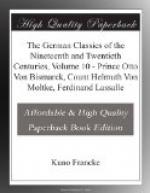But the height of his literary mastery is reached in 1841 by the publication of the Letters on the condition and events in Turkey from the years 1835 till 1839, the matured fruit of those eventful and adventurous but, at the same time, constructive years in the Orient. They have been likened to Goethe’s Italian Journey. The comparison is justified by striking resemblances. Both works have resulted from diaries and letters actually kept, Moltke’s work, however, more faithfully retaining and professing its formal nature. But the resemblance is much closer, arising, in the so-called inner form, from a similarity of attitude, the same wide extent of interests which may be briefly called “kulturgeschichtlich,” and, above all, the scientific concern in the country and its inhabitants, to which both brought the most solid and methodical qualifications. It is true, the wealth of Italy, both of antiquity and of the Renaissance, in matters literary and artistic, so exuberantly mirrored in Goethe’s book of travel, is not to be found in Moltke’s work. But this lack is counterbalanced by those portions dealing with historical events which Moltke actually experienced and even influenced; events, though then unsuccessful, as far as his intentions were concerned, yet important and significant for our own time, as the recent developments on the Balkan peninsula bear ample evidence. Both, Goethe as well as Moltke, are clever and artistic in handling pencil and brush as well as their descriptive pen.
And now the style, in the narrower sense. It is natural, limpid, free from all rhetorical flourishes and wordiness, placing the right word in the right place. Xenophon, Caesar, Goethe, come to mind in reading Moltke’s descriptions, historical expositions, reflections. Bookish terms and unvisual metaphors, which occur in the preceding pamphlets, though rarely enough, are entirely absent. The tendency toward military brevity and precision is everywhere obvious. The omission of the cumbersome auxiliary, wherever permissible, already characteristically employed in his tale, is conspicuous, as in all his writings and letters. The words are arranged in rhythmical groups without falling into a monotonous




